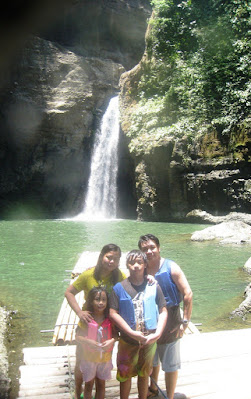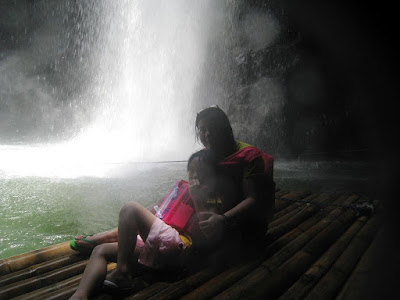The boat trip starts from Pagsanjan.
The real excitement is on the boat's return trip. This is what was dubbed "Shooting the Rapids". See how skillfully the boatmen will manuever the boat between rocks, alternately using their paddle or their feet. There are places that the rapids is on a curve but the boatmen will guide the boat through it. If the paddle is not enough to steer, the boatmen's feet surely will.
There are at least 16 rapids (turbulent waters) that the boat has to go through. Going upstream, the boatmen will get down at these rapids and push the boat or use their feet to kick the rocks and propel the boat upstream. At places where the rocks are too many and the water is too shallow, steel pipes were placed transversally at proper intervals so that the boat can be slid over these pipes.
Tips:
Although not required, it is advisable to wear a helmet (a sports helmet or hard hat) because the boat moves too close to the big rocks which your head might hit. Also, the walls of the gorge is too high, that any falling object from it, such as small stones, can do some damage to an unprotected head. Rarely, some monkeys along the gorge are fond of throwing objects at those boats.
Don't look funny wearing clothes as if you're going to the mall. Be ready to get wet. Have plastic bags for your cameras, wallets and other keep-dry-items. There is no use for your cellphones once the boat entered the gorge - that is when you entered Cavinti. GPS receivers works fair but loses signal at some portions.
--Waypoint narrative by: GBLontok 2004
Do you know that the world-famous Pagsanjan Falls is actually not in Pagsanjan? This famous tourist destination is located in Brgy. Anglas, Cavinti, Laguna. A big "WELCOME TO CAVINTI" sign erected on top of a big rock on the river on the way to the falls will let the tourists know that they are no longer in Pagsanjan - I do not know if foreigners care about this fact. Enclosed in parenthesis in that sign is the name Magdapio Falls which is the preferred name by Cavinti folks. From this point facing upstream, the left bank is belongs to Lumban and the right bank belongs to Cavinti. In fact, Pagsanjan Falls drops water from Cavinti River. If you have been to Cavinti, this is the river crossed by the overflow spillway on the road going to Lumot.
Another waterfalls, Talahib Falls, situated about 900 meters downstream of Magdapio Falls serves a first stop for the upstream boat ride. Talahib is a sitio of Brgy. Caliraya, hence, the town of Lumban hosts this waterfalls. This waterfalls is also called First Falls while the Magdapio Falls is called Main Falls. The Talahib Falls area has a souvenir shop, barbeque stand and most important, a pay-toilet for PhP10 per pee.
Another waterfalls, Talahib Falls, situated about 900 meters downstream of Magdapio Falls serves a first stop for the upstream boat ride. Talahib is a sitio of Brgy. Caliraya, hence, the town of Lumban hosts this waterfalls. This waterfalls is also called First Falls while the Magdapio Falls is called Main Falls. The Talahib Falls area has a souvenir shop, barbeque stand and most important, a pay-toilet for PhP10 per pee.
At the Main Falls (or Magdapio Falls or Pagsanjan Falls), the main attraction aside from a view of the falls itself is the raft ride. Skilled raftmen will bring tourists aboard bamboo rafts by pulling on ropes laid across the lagoon. They will bring you to the far end to have a glimpse of another cascade on top of the Main Falls. Another rope guides the raft behind and underneath the falls to the Devil's Cave. At the cave, visitors enjoy playing with their echo by shouting to their lung's desire.
It is interesting to note that the raft services is maintained by the Cavinti municipal government. Rightfully so, since they are the one hosting the attraction. Reciprocally, the revenue is shared with other host towns.
The raft crew has established a trail for their own use. It includes a series of ropes for the vertical portion. Even skilled mountaineers would not be allowed to use this trail for safety reasons - one wrong step will send down a small stone deadly for the people at the bottom.








No comments:
Post a Comment